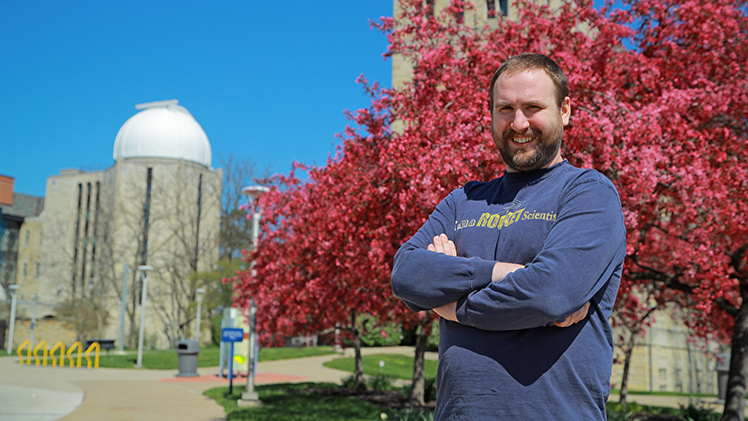In the grand scale of stellar evolution, protostars represent a very short-lived period.
“Protostars only last a half a million years or so,” said Sam Federman, a doctoral candidate in physics who studies them at The University of Toledo. “Cosmically, that’s the blink of an eye.”

Physics Ph.D. candidate Sam Federman is lead author of a recent research article in the Astrophysical Journal.
Astronomers are interested in zeroing in on this blink-and-you’ll-miss-it period in the life cycle of stars, when balls of gas that are not yet stars increase rapidly in temperature and mass. The processes involved help to shape not only the stars but the solar systems and galaxies around them.
Federman is advancing this goal as lead author of a recent research article in the Astrophysical Journal. It’s among the first peer-reviewed papers to parse protostellar data and observations from the James Webb Space Telescope, which, with its unprecedented infrared astronomy capabilities, offers a new and valuable peek at accretion and accretion-driven outflows in five young protostars.
Accretion is the process by which these soon-to-be stars accumulate gas and dust particles from their surrounding environment.
“Ultimately we want to know how you go from a cloud of gas to a star surrounded by planets,” Federman said. “There’s still a lot that we don’t know about this early stage. These data can give us insights into how a protostar grows and how it interacts with its environment.”
Dr. Tom Megeath, a Distinguished University Professor in the Department of Physics and Astronomy, is the principle investigator on the observation program that yielded the data. He’s collaborating on the program with an international team of more than 30 astronomers including Federman, who is set to complete his doctoral program this summer and then begin a post-doctoral research fellowship at the INAF-Osservatorio Astronomico di Capodimonte in Naples, Italy.
Their research is significant for its first-time use of the new space telescope to cut through the dense envelope of dust and gas that surrounds the protostars and obscures them from view at visible and shorter wavelengths. Because Webb observes at infrared wavelengths, astronomers can track protostellar accretion and related processes across the mass spectrum.
Stars accumulate most of their total mass during the first 100,000 years of the protostellar phase. That accumulation of mass, or accretion, also drives powerful outflows in the form of collimated jets and wide-angle winds that clear cavities in envelope and sweep up infalling gas.
In addition to advancing astronomers’ understanding of these important protostellar processes, Federman said he expects their research to be of interest to theoretical astronomers.
“They can use our data in their models when they’re looking at large-scale simulations of the universe,” Federman said. “That can help predict how outflows affect the cosmic environment.”
Federman, of Sylvania, is a two-time Rocket. He completed a bachelor’s degree in physics in 2017 before he returned to UToledo’s Ritter Astrophysical Research Center and began working toward a doctorate with Megeath in 2018. When Megeath learned his proposal was selected for the first cycle of scheduled observing time on Webb – and allocated more than 65 hours, making it the second-largest observation program dedicated to stars in that cycle – Federman was well positioned to seize a groundbreaking opportunity.
“This has been a huge opportunity,” Federman said. “It also positioned me very well for my post-doctoral fellowship in Italy, where the work is similar in many ways to what I’m already doing. I’ll continue to use Webb data to learn more about protostars.”
Federman also plans to continue his work with Megeath, who was recently informed of a second successful proposal for an observation program on Webb. One of three UToledo-led programs included in the highly competitive third cycle of scheduled observing time, this protostar-focused program was allocated nearly 175 hours on the telescope, accounting for the third largest project in this cycle and the largest-ever project on the formation of stars in our galaxy.
“Due to Sam’s enthusiasm, persistence, skill as a researcher and great teamwork, we have published the first comparative study of five protostars observed with the James Webb Space Telescope. Already, the preprint of the paper is getting international attention,” Megeath said. “This is just the beginning, though. I look forward to working with Sam and his collaborators in Naples as we receive data from the largest study of protostars planned for Webb.”